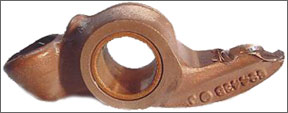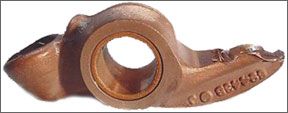Let Kunovice: L-23 Super Blanik Cracked Elevator Hinge Brackets During a 100-hour inspection, several cracks were discovered on the inboard elevator hinge bracket (p/n A730258N). Additional cracks were found on the seven aircraft after a fleet- 288 wide, one-time inspection was completed. Aircraft times varied from a low of 2507.7 hours to the group high of 2740.3 hours. The difference is a mere 232.6 hours, with 2671.4 the average of the seven records. Everything is cracking right on schedule-you could plan a vacation period around these numbers. Part Total Time: 2671.4 (average) Pilatus PC-12-47 Cracked Flap Drive Arm Assembly The crew received a flap warning light on rollout after landing. Several E211 codes were generated by the crew alert system, indicating flap errors. On inspecting the left inner resolver installation, its drive pin was found pulled from the socket. Further inspection found the inboard, l/h flap drive arm assembly (p/n 527-52-12-153) cracked in several places. No further damage was found. Part Total Time: 8000.0 hours Lycoming TIO-540 Cracked Engine Case The operator requested troubleshooting of low oil pressure on the r/h engine of a Piper PA-31-350. The technician discovered oil film on the l/h engine case. Further inspection revealed a 1.3-inch crack on the case half at the number four cylinder (forward top stud area). Run-up revealed oil coming from the suspected crack area. Part Total Time: (unknown) ECI Cylinder Failed Valve Keys The valve keys (p/n 60009) are pulled through the spring seat (p/n AEL 10077) of this Lycoming O-320 cylinder, according to the submitter. The rocker arm tip is destroyed. A hole wore through the valve cover from the upper spring seat, and the valve keys were stuck on the valve stem. This valve stem is damaged and will not pass through the valve guide. Part Total Time: (unknown) Superior SA52006A20P Cylinder Stuck Exhaust Valves The IO-520-L engine powering a Cessna 210L was undergoing a 50-hour inspection which revealed an oil leak on the r/h side of the engine. Further investigation revealed the exhaust push-tube seals were leaking. Removal of the push-tube and rod showed the push rod was bent. The oil leak was caused by the push rod displacing the seals on the push tube. Additionally, the exhaust valve had contacted the face of the piston. All other pistons on the engine were checked-a total of three pistons were found with exhaust valve contact. Part Total Time: 1081.0 hours




